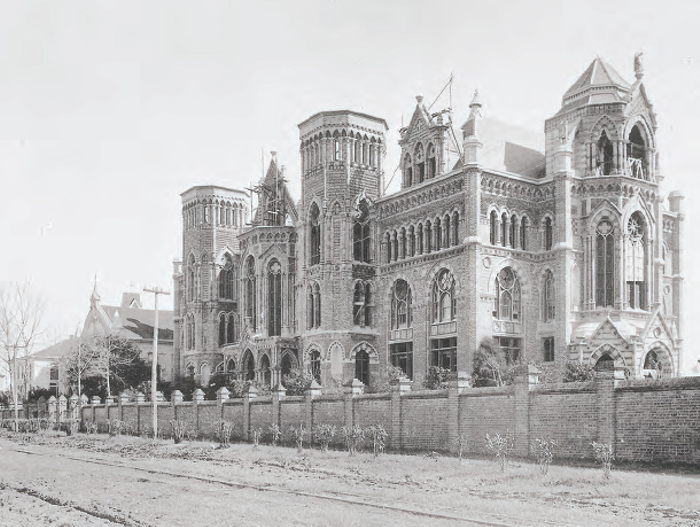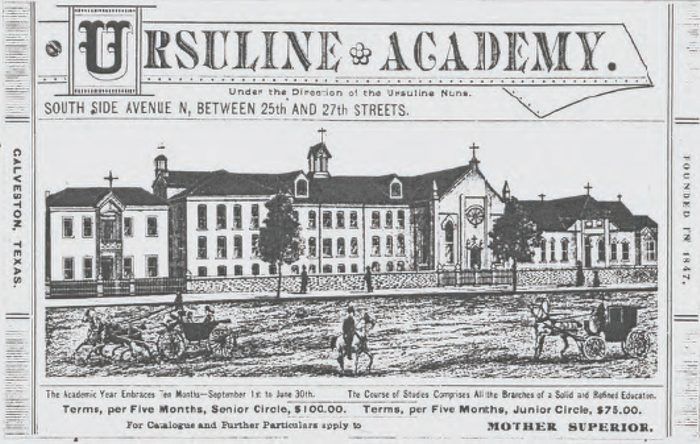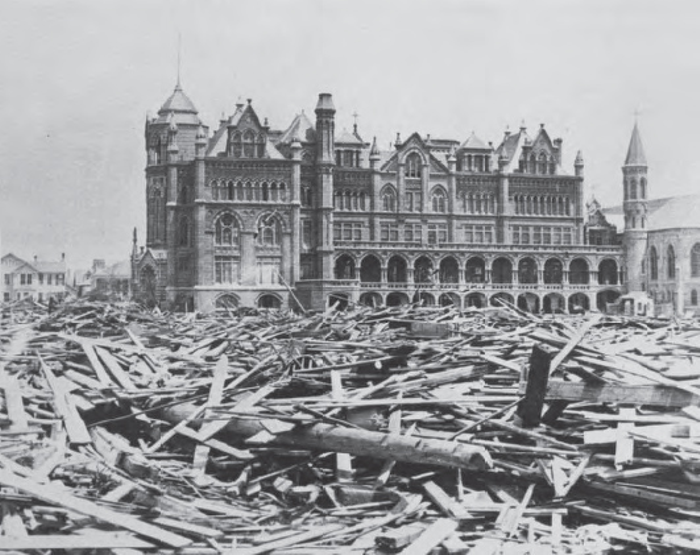Although the term “Ursuline” can refer to a number of different institutes within the Catholic Church, the most well known group - and the one to which Galveston is beholden - was founded in 1535 in Brescia, Italy.
Organized and led by Saint Angela Merici, the Order of St. Ursula was canonically instituted by Pope Paul III (1534-1549) for the education of girls and the care of the ill and underprivileged. Merici had chosen the brave and sacrificial Saint Ursula as the order’s patron saint, a legendary figure said to have embarked upon a pilgrimage with 11,000 virgins, all of who were beheaded by the Huns in a massacre in 384 AD, while Ursula herself was killed by an arrow off the bow of their leader.
The Ursuline Order, known informally in their early years as St. Angela’s Daughters, in 1639 became the first female educators to travel across the Atlantic Ocean to North America. Once in Quebec, they established Mother Mary of the Incarnate to educate the children of both Native American tribes and French settlers.
A century later, they had forged a path all the way south to the mouth of the Mississippi River and established the Convent of New Orleans in 1727, which was soon regarded as a pioneer of education for youth among the territories that would eventually become the United States.
On January 16, 1847, seven noble nuns set off from this esteemed institution for a two-day trip across the Gulf of Mexico on a ship appropriately named the Palmetto. They landed at the Port of Galveston in the late evening hours of January 18, 1847, and they were greeted by Mesdames Blossman, who escorted them to her home to rest for the night. Thereafter, Mrs. Blossman remained steadfast friends with the Ursuline nuns, and a long line of her descendants attended Ursuline Academy.

The next morning, the tiny community took possession of their first convent located on what is now Avenue N between 25th and 27th Streets. Sprawled across nearly ten acres, the property included a simple, white, woodframed structure that measured two-stories high with nine rooms. It was purchased for a reasonable $10,000, but the grounds and the house had been vacant and neglected for more than two years.
The seven Ursuline nuns quickly went about arranging their new home and schoolhouse, first selecting a room to designate and outfit as the chapel. Since the island population was sparse and still in its infancy, the nuns had little outside assistance, but two volunteers from the Ursuline Convent of Quebec were sent to help tend to the fields and fertile gardens that surrounded the new Galveston convent.
The school opened soon after the sisters’ arrival. Initially, it accommodated day students only, but the demand for boarders grew rapidly, and within a few months, construction began on a dormitory and refectory. In 1851, these wood-frame buildings were joined by a convent (or monastery) — a three-story building designed in Greek Revival with a stucco finish to resemble stone. When the dormitory was partially destroyed by a fire in 1854, a decision was made to rebuild it with brick.
It was designed by a Mr. DeYoung, and construction was overseen by two local reverends. Twice during the build, the nearby lime shed caught fire, and the work-in-progress narrowly escaped ruin. In 1855, when the dormitory was nearly complete, a yellow fever epidemic swept through the island city. For much of 1857 and 1858, Ursuline Academy was, for the most part, closed,
although the nuns remained to help care for the stricken.

Despite this run of hardships for the Ursuline Order in their first decade on Galveston Island, their provision of fine education became well known across the state, and attendance swelled. By 1861, another wing was needed, and work began early that year with a goal of having it completed in time for the fall term — but the United States government had other plans.
With the onset of the Civil War, the nuns' services were again diverted from their students. On September 10, 1861, the Ursuline nuns converted their still-unfinished building into a hospital, and they volunteered as nurses. They served Confederate soldiers in the beginning, then Union soldiers when the North won control of the island in 1862, but their most formidable test came on New Year’s Day 1863, during the Battle of Galveston.
Troops who infiltrated the city on the morning of the battle conveyed that Confederate General J. Bankhead Magruder offered the nuns the use of his ambulance to flee the downtown area and find safety away from the conflict. They refused, electing to remain at their convent hospital and administer care to the wounded.
It was suggested, then, that they fly a yellow flag atop their building to indicate that it was a neutral zone. The nuns possessed nothing so whimsical as yellow garments, but they discovered a bright yellow petticoat among the possessions of a postulant who had recently been accepted into the convent. In a rather comic tableau, the flying yellow female undergarment temporarily marked a community of nuns.
The battle commenced and the “continuous shelling” of the city for hours on end resulted in hundreds of injuries and casualties, but the sisters never faltered. On March 18, 1918, the Honorable Ambrose Kennedy of Rhode Island addressed the House of Representatives with a petition for a resolution to memorialize the nuns who risked their lives during the war.
Kennedy wrote: “The records of war do not register a single instance of failure or shirking on the part of the Sisterhoods, and it must have been an edifying sight indeed to behold these pious and unassuming women, whose souls were enriched with the jewels of heavenly sanctity, as they went from battlefield to hospital to apply their tranquil ministrations.”
Registration for Ursuline Academy opened nearly as soon as the canon fire ceased, and it quickly filled to a capacity that surpassed its pre-war years. Still, the country was now laden with the arduous tasks of Reconstruction, and the years following the war were difficult for the sisters because of their willingness to accept payments of severely depreciated Confederate currency for tuition and board.

The academy managed to pull through these lean years, and a chapel was erected on the Ursuline grounds in 1871. Built in a Gothic design, the small but regal, two story edifice included a bell tower and a wrap-around gallery that directly connected it to the monastery. Then, in 1874, another frame building was constructed to house commencement ceremonies, as well as a free school called St. Angela’s. n October 30, 1882, cries of “fire!” rang out across the campus. The sisters and their neighbors took swift action, but the entire roof of the public schoolhouse burned before the fire engines arrived.
Fortunately, the blaze was extinguished before it was able to spread to the walls and floors of the building, so the undamaged portions were moved to the west side of the chapel and repairs were made. The building remained there until 1891, when it was moved to make way for Nicholas Clayton and his behemoth.
The colossal design of Galveston’s most notable Victorian era architect took nearly four years to build and was completed in early 1895. Bright red and orange brick were structured with Clayton’s trademark tapestry style and intertwined with towering stained glass windows, flying buttresses, and massive wooden doors guarding the main entrance.
The building seemed poised in a position of perpetual praise, with gorgeous vertical lines, ornate cornices, and tapered rooflines that all looked as if they were reaching towards the sky in adoration of the heavens. The Victorian Gothic masterpiece was a spectacle that still managed to maintain a distinct air of solemnity so as not to betray its intended purpose.
During the 1900 Storm, the academy building held fast and served as a refuge for 1,500 people, many of who remained there during the aftermath as they sought to rebuild their homes. The sisters turned away no one in need of shelter, and cared and provided for them at their own expense. The valorous building must have seemed indestructible at the time, but sixty years later, a hurricane would in fact be its undoing.
After Hurricane Carla struck in 1961, church officials deemed the damage irreparable even though many residents maintain to this day that it could have been saved. In early 1962, the decision to demolish was finalized. Acting quickly so as to limit any further speculation on the matter, the plan received little attention and both the Academy and the Chapel were torn down brick by brick. Soon after, a fundraising campaign was launched for a new building.
The most recent version of the academy that stands today was completed in 1963, but in the meantime, school was held inside the Hutchings and Sealy Building on the northeast corner of Strand and 24th Street. By 1968, more than one thousand girls had graduated from Ursuline Academy, when it consolidated with Kirwin Catholic High School and the Dominican Girls School to become O’Connell High School.
The convent building remained on the Ursuline grounds until 1973. Several attempts were made to save it, with a number of residents supporting its conversion into a cultural arts center and others merely trying to maintain its historical significance, but at last it too was demolished to make way for an athletic program at the junior high campus.
Had it been spared, the convent would presently be one of the oldest buildings on the island. Sadly, it was lost, but the heroic Ursulines and their magnificent academy still remain, forever emblazoned on the heart of Galveston’s memory.